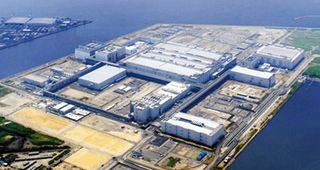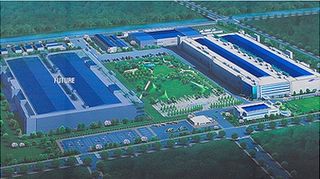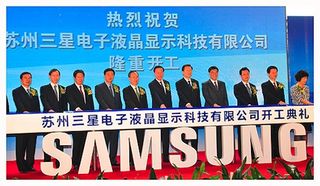It's been a turbulent week or so in the TV business, starting with the news that Panasonic and Sony, once the driving forces of TV manufacturing, are looking to form a joint venture to develop OLED TVs in order to maintain competitiveness with their rivals from South Korea.
But the Koreans are looking beyond 'made at home', too: both the big brands – LG Display and Samsung – have just started building massive LCD plants in China.
That the company once able to sell products with the simple statement 'It's a Sony', and the headline TV sponsor of this summer's Olympics. have to resort to measures such as their joint venture shows just how precarious the business of making TVs in Japan has become.
In the past it proved too rich for the originator of plasma TV, Fujitsu, and famously Pioneer aimed to set its products above the mass-market to ensure profitability and failed.
Last week Toshiba announced it was ending TV manufacturing in Japan, and even European company Philips has all but removed its exposure to the vagaries of this cut-throat market.
Philips-branded TVs in the North American market have for some time been made under licence by Japanese company Funai, and now it has a worldwide joint venture with TPV – one in which the Hong Kong-based partner owns 70%, and Philips just 30%.
Similarly Sony has sold off its European TV plant as part of its decision to end in-house manufacturing of TVs, has sold its stake in the S-LCD joint venture back to partner Samsung, and has just announced it's pulling out of its joint venture making LCD panels with Sharp.

That joint venture was set up in 2009 with the opening of the state of the art Sakai factory (above) of Sharp Display Products Corp, in which Sony held a stake of just over 7%. Just a couple of years ago Sharp was hopeful Sony would increase its investment to a planned 34%. but this time last year Sony announced its plans to boost its stake were on hold .
A couple of months ago Sharp, along with Sony making huge losses in its TV division, announced it was halving LCD TV production at Sakai; this week came news that Sony was pulling out of the deal.
Where this leaves Sony isn't clear: apart from the Panasonic tie-up on OLED, it has cut its ties to LCD panel manufacturers, so looks likely to be reduced to buying panels on the open market. On the upside, this could mean it's able to take advantage of fluctuations in panel prices; the downside is a further step away from manufacturing.
Sharp, meanwhile, has bounced back from the collapse of the Sony deal, and is reported to be forming an alliance with the world's largest electronics manufacturing service, Taiwan-based Hon Hai Precision Industry Co.
Hon Hai, which makes a huge range of products in China for a variety of companies – most famously perhaps iPhones and iPads – will build a new factory in Chengdu, which is in China's Sichuan Province. Sharp will contribute the kind of advanced LCD panel technology it has been developing at Sakai.
And China seems to be where the two TV market-leaders – Korea's LG Display and Samsung – are looking for the next step in their TV plans. This week, 18 months after gaining approval from the Beijing government, LG broke ground on an eighth-generation plant to make panels for 50-55in TVs.

Built on a 695,000 sq m site in Guangzhou (above), it should be in mass-production some time in 2014, and is 70% owned by LG, with the rest shared between the local government and Chinese TV company Skyworth.
The site has been chosen for its proximity to companies LG Display serves with TV panels, including Skyworth itself, Konka and TCL.

Not to be outdone in what is now the world's largest market for LCD TVs, Samsung Display last week started construction of a similarly massive LCD panel plant in Suzhuo, eastern China (above), which will also make panels using eighth-gen glass.

Like LG's, the Samsung factory has been planned for a while – this ceremony was around two years ago – but having held fire due to the falling price of LCD panels on the world market, Samsung now plans to have it up and running early in 2014.
And a report in The Korea Times suggests that plans for these plants to make LCD TVs are just a small part of a longer-term strategy to make OLED panels in China.
It quotes a Samsung official as saying 'Yes, may shift our LCD-making facilities to lines that produce large-sized OLED screens for use in TVs: Samsung’s first China LCD plant will shift to OLED lines from the latter half of or early 2015 as the company believes the market will open a few years later.'

He suggested that if the company decided to go down this route, 'the Chinese government will welcome us as Samsung will be the leader in OLED technology in terms of production capacity.'
Meanwhile an LG executive didn't rule out a similar switch for its China plant: 'This is all about customers. If customers want, then we do it: our internal studies indicate that consumers will start buying OLED TVs once the price falls to 1.3 to 1.4 times that of an LCD set.'
With such ambitions from the two Korean companies, it's clear the onus is on Panasonic and Sony to get moving with their OLED joint venture, and be in a position to compete when those two massive Chinese plants come on stream in a couple of years.
However, where the Japanese companies will be making – or perhaps just buying – their OLED panels by then remains to be seen…
